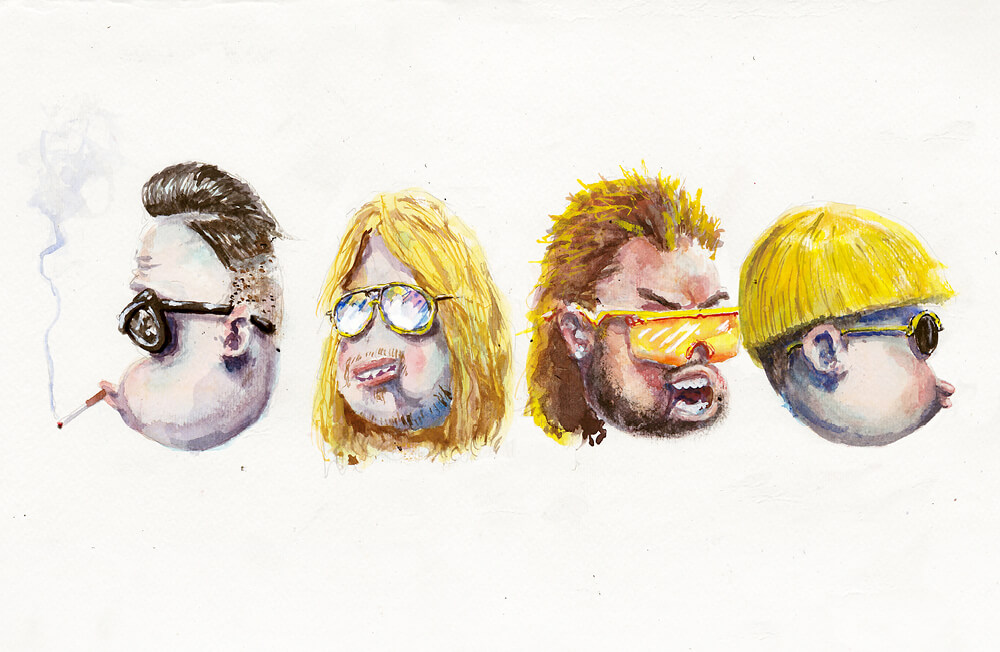No products in the cart.
The Short History Of Surf Hair
Like the light from a distant supernova, hair is dead by the time you can see it. So it’s surprising how much we carry on about it. Hair is one of the hallmarks by which non-surfers love to stereotype surfers, yet the truth is that our rugs are as diverse as our approaches to the ocean. If we had indeed been typecast by our surfing forefathers we’d all look like Tom Blake: short back & sides with a light bleach, eerily reminiscent of a Kennedy brother yacht-frolicking at Hyannis Port.
But even the most well-planned garden will sprout under the right growing conditions, and by 1966 there’d been enough sun and water applied to Midget Farrelly’s scalp that by the time he hit Bells he looked like a deranged Santa Claus. Terry Fitz, of course, was not far behind. For all of his attention to hydrodynamics, it seems he overlooked the wind drag of a ’fro with a three-foot diameter.
But for every prominent surfer who sought maximum aeration (in this, and so many other respects, Buttons was a trailblazer), there were others who aspired to a kind of zen-inspired globe comprised of perfectly straight strands. The early ’70s bowl cut, with its glowing halo of reflected sunlight, brings Greenough to mind. But also Lopez and, surprisingly, Rabbit.
The 80s were a brutal time for surfer hair, as they were for surfboards, surf fashion and hell, let’s face it, humanity itself. Far worse than Reagan, Thatcher, Iran Contra and acid rain was the Mullet. Arguably, surfers weren’t as heavily afflicted by this hideous trend as, say, footballers or even tennis players. But nor did we escape unscathed: MR, for all of his many achievements, was short up front and rockin a hell of a party out the back.
Mark “Sanga” Sainsbury innovated by inventing the floater and a hairstyle which owed a fair bit to the echidna. Elsewhere on the mean streets of the 80s, rockers gelled and brylled up while surfers bleached: each accusing the other of vanity. Women identifying with either tribe paid good money to have their hair burnt and mechanically wrenched into fantastical perms, perched on top of shoulder pads that were inspired by the various military dictators getting around at the time. The only woman in the surfing universe who was cool enough to resist all the fads with ease was one Jodie Cooper. Never before or since has a simple bob come to represent so much competitive fire.
WB Yeats was a man with a startlingly good quiff. He also had an expression for what happened next with hair: Things fall apart: the centre cannot hold. Once we got through the drudgery of the 90s, where hair mirrored board design by failing to evolve at all, the millennial changeover brought with it a flurry of random activity. Frankenreiter taught us to express ourselves with face hair, a notion that had left surfing along with MP’s wonderfully sinister mo in the mid-70s. Machado combined phenomenal grace and social consciousness with a head of hair that was frequently booked an extra seat on long haul flights. Brazilians appeared on the pro tour. Mick Campbell struck a blow for ripping gingers, and Parko emerged with improbably neat Lego-Man hair that could do the Kirra equivalent of James Bond parachuting out at 30,000 feet then walking into the Swiss embassy in a tux. Matt Chojnacki brought pomade and shaved sides out into the light. And then…
Then there was Craig Anderson. As far as anybody could tell, Monsanto had crept in and genetically mapped the most perfect elements of surfer hair, then grafted them onto a kid from Port Elizabeth and planted him in Newcastle. Volume, shades, length. Hairstylists the world over sigh at the creative hand of Mother Ocean. In theory, Ando’s hair would be the end of evolution, the point at which mutation ceases its restless march. But for one guy.
Eleven world titles. Sixty-eight career wins. The man who shaved a foot off thrusters and then switched to quads while we were all working out how to ride these new stumpy things. Who at 42 just landed one of the biggest airs in history.
And who has no hair on his grizz at all. Kelly, as in all things, inverts the dominant paradigm.
